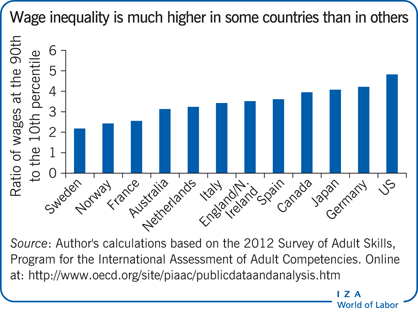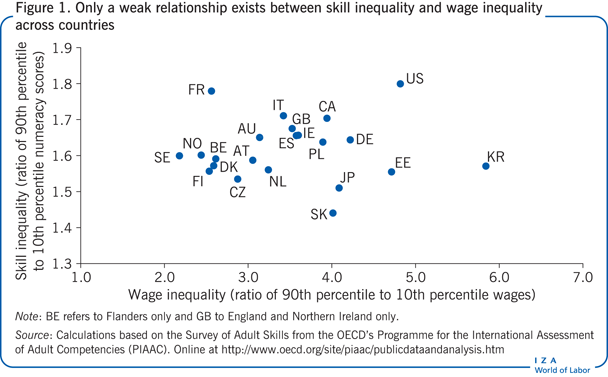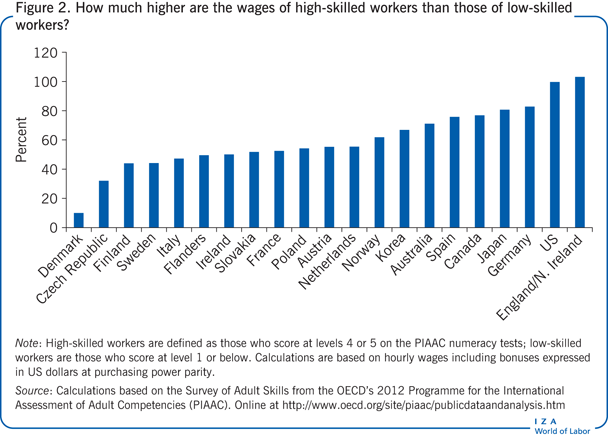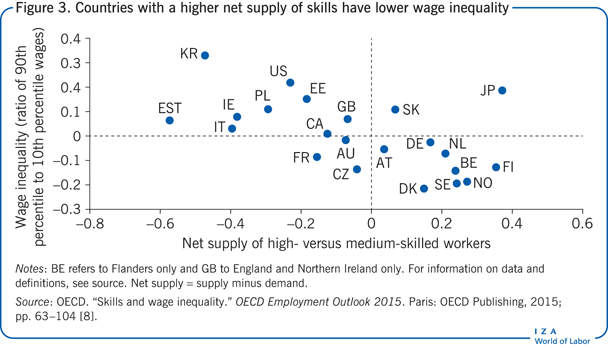Elevator pitch
Policymakers in many OECD countries are increasingly concerned about high and rising inequality. Much of the evidence (as far back as Adam Smith’s The Wealth of Nations) points to the importance of skills in tackling wage inequality. Yet a recent strand of the research argues that (cognitive) skills explain little of the cross-country differences in wage inequality. Does this challenge the received wisdom on the relationship between skills and wage inequality? No, because this recent research fails to account for the fact that the price of skill (and thus wage inequality) is determined to a large extent by the match of skill supply and demand.

Key findings
Pros
Skills matter for wages at the individual level: skilled workers have, on average, higher wages than unskilled workers.
Differences in skills can explain a significant share of the wage gap between certain socio-economic groups.
Changes in the demand for skills, driven by technological change, globalization, population aging, and organizational changes, have increased the return to skill and, thereby, wage inequality.
Wage inequality tends to be lower in countries that are better at meeting the demand for skills.
Cons
Differences in skills and in their distribution account for only a small fraction of differences in wage inequality between countries.
Differences in the prices of skills (or how skills are rewarded) account for a much larger proportion of cross-country differences in wage inequality.
The prices of skills are determined, at least in part, by labor market institutions, which have an important impact on the distribution of wages.
A large portion of cross-country differences in wage inequality remains unexplained by skills or skill prices.
Author's main message
While cross-country differences in skills and their distribution explain only a small part of international differences in wage inequality, it is wrong to conclude that skills do not matter for wage inequality. Differences in wage inequality across countries are driven primarily by differences in the return to skills, which is determined in part by labor market institutions, but also by how well the supply of skills meets the demand. A comprehensive policy package to tackle wage inequality should include a focus on skills, reforms of labor market institutions that influence how skills are rewarded, and alignment of skill supply and demand.
Motivation
A large and growing body of evidence has helped policymakers better understand the causes of both high and rising wage inequality. Two key sets of explanations have emerged. For the first set, which focuses on labor market institutions, there is general agreement that changes in minimum wages, unionization, and employment protection legislation, or differences in them across countries, can explain a substantial portion of the increase or cross-country variation in wage inequality. For the second set of explanations, which focuses on the role of skills, there are two competing strands of research. One strand, with many supporters, finds that changes in the demand for and supply of skills have caused rising wage inequality within countries over time. Yet another strand has found that skills explain little of the differences in wage inequality across countries. For policymakers, these findings may send mixed messages about the importance of skills in tackling wage inequality. The objective of this paper is to provide clarity on this issue.
Discussion of pros and cons
Skills explain very little of the international differences in wage inequality
The idea that skills and worker training enter into the determination of individual wage rates dates to at least Adam Smith. The notion received fresh impetus from the development of human capital theory in the 1960s, which provided a strong theoretical and quantitative foundation for the relationship between skills and wages. Since then, estimates of the return to education, virtually all positive (and frequently large), have flourished in the economics literature, and increases in the return to skill have featured prominently in explanations for the rise in inequality in a large number of developed countries in recent decades [1]. While most of the literature has used proxies (like occupation or educational attainment) for measuring skills, recent studies have begun to use more direct measures of (primarily cognitive) skills and have replicated many of the well-established findings in this literature.
Against this backdrop, a small but growing literature has found that differences across countries in the distribution of (cognitive) skills appear to explain very little of the differences in wage inequality across countries. Taken on their own, these studies may leave the impression that skills do not matter for wage inequality.
The standard approach in this research is to use decomposition methods to analyze three components of international differences in wage inequality: one due to skills (sometimes referred to as an “endowment” or “composition” effect), one due to how skills are rewarded (or skills “prices”), and one that remains unexplained (or a “residual”).
The first group of studies, which appeared in the early 2000s, was based on the International Adult Literacy Survey, carried out between 1994 and 1998. One of the studies found that the distribution of test scores could explain, on average, only 3–13% of the higher wage inequality observed in the US [2]. Another found that skills inequality could account for only about 7% of cross-country differences in wage inequality [3]. More recently, a number of studies have exploited data from the OECD’s Programme for the International Assessment of Adult Competencies (PIAAC) for similar purposes and obtained essentially similar results: differences in the distribution of skills across countries can explain little, if any, of the differences across countries in wage inequality [4], [5], [6].
In a way, such conclusions are not surprising. Even a cursory look at the aggregate cross-country data suggests that there is little correlation between skill inequality and wage inequality (Figure 1). While there are countries with both high skill inequality and high wage inequality (such as Canada, Germany, Italy, and the US), and others with both low skill inequality and low wage inequality (Scandinavian countries), there are also countries with high skill inequality but low wage inequality (such as France) and some with low skill inequality and high wage inequality (such as Japan and Korea).

The second important observation to take away from Figure 1 is that the variation across countries in skills inequality is fairly low: the ratio of numeracy scores at the 90th percentile to those at the 10th percentile ranges from 1.4 in Slovakia to 1.8 in the US. There is much more variation across countries in wage inequality: the ratio of wages at the 90th percentile to those at the 10th percentile ranges from 2.2 in Sweden to 5.8 in South Korea.
Does the fact that differences across countries in the distribution of skills explain very little of differences in wage inequality mean that countries with high wage inequality should not be concerned about skills? The very simple answer is no. There are at least two important reasons why countries should invest in skills if they are worried about wage inequality. The first is that there is a strong relationship between an individual’s skills and wages. So within countries, a wide skills gap between the highest skilled workers and the least skilled ones necessarily implies wider wage dispersion. The second reason why countries with high wage inequality should be concerned about skills is that the skills premium (and therefore wage inequality) will increase if the demand for skills is high while the supply of skill fails to keep up with demand. Even at a cross-country level, there is evidence that countries that are better at meeting the demand for skills tend to have lower wage inequality. In what follows, each of these arguments is explored in turn.
Individuals with higher skills have higher wages
The first (and simplest) argument for why policymakers who are concerned about wage inequality should focus on skills is the strong association between an individual’s skills and wages. Figure 2, based on the latest round of the adult literacy surveys (PIAAC), shows that workers who can understand a broad range of complex mathematical information (scoring at levels 4 or 5 on the numeracy tests) have wages that are, on average, 60% higher than adults who lack the basic numeracy skills required for performing many everyday tasks (scoring at level 1 or below). In some countries, like England/Northern Ireland and the US, the wages of high-skilled workers are twice as high as those of low-skilled workers. More formal estimates of the return to skill, which control for a range of other characteristics that might affect wages, find, on average, that an increase of one standard deviation in numeracy skills is associated with an 18% increase in wages among prime-age workers—ranging from 12—15% in the Scandinavian countries to as much 28% in the US [7]. These studies find that skills proficiency plays an independent role as a determinant of wages, over and above the role played by formal education.

With a considerable wage premium attached to skills, it is not surprising that skills explain a significant portion of the wage gap between certain socio-economic groups—which is a second piece of evidence supporting the link between skills and wage inequality. Across the 22 OECD countries that participated in PIAAC, wages are 18% higher for men than for women; 36% higher for older workers (aged 50–56) than for younger ones (aged 16–29); 20% higher for workers with at least one parent with a higher education than for those whose parents have only a lower secondary education; and 15% higher for workers who are native-born than for those who are foreign-born. Recent analysis shows that differences in skills can account, on average, for 83% of the wage gap between workers with different levels of parental education and 72% of the wage gap between native- and foreign-born workers. By contrast, skills explain a much smaller (but still substantial) part of the wage gap between men and women (23%)—suggesting that factors others than skills are responsible for the bulk of gender wage disparities. Finally, younger workers would earn even less relative to older workers if they had equivalent numeracy skills; however, younger workers tend to have higher numeracy skills than workers in previous generations [8].
Cross-country difference in wage inequality are primarily driven by differences in returns to skill
Studies that find that skills cannot explain cross-country differences in wage inequality tend to conclude that differences in how skills are rewarded are far more important—to use the terminology introduced above, the “skills price” effect is much larger than the “skills endowment” effect. For example, an early study based on data from the 1990s found that higher skills prices in the US than in other countries could account for 18–55% of the difference in wage inequality between them [2], a finding confirmed by another study using the same data that placed the estimate at around 36% [3]. More recent calculations using PIAAC 2012 data provide estimates in the same ballpark, ranging from about 33% [5] to 57% [6]. These results are not surprising in light of the large variation across countries in the return to skill documented in Figure 2.
The return to skill is determined (at least in part) by labor market institutions
Most of these studies go on to claim that differences in the return to skill must be driven by differences across countries in labor market institutions, in particular, wage-setting mechanisms that influence how skills are rewarded. For example, higher minimum wages will compress the wage distribution and therefore reduce the return to skill. Similar effects might be expected in countries where the wages of a large portion of workers are set through collective bargaining.
Indeed, there is substantial evidence to show that labor market institutions are significant both in determining wage inequality over time within countries and in explaining different levels of inequality across countries. For example, several studies have concluded that the decline in the real value of the minimum wage has been responsible for part of the rise in inequality in both Mexico and the US and that falling industry-based minimum wages contributed to rising inequality in the UK in the late 1980s and early 1990s. The decline in the share of workers who are members of trade unions is another factor that has been associated with rising wage inequality, particularly in English-speaking countries and Japan. Finally, labor market regulatory reforms aimed at increasing flexibility (in particular the relaxation of employment protection legislation for fixed-term and temporary agency work contracts) are also asserted to have contributed to the rise in inequality in OECD countries through the expansion of non-standard employment that they have encouraged [8]. Some estimates from a comparative study indicate that, over the period 1973–1998, changes in labor market institutions could account for a 23% fall in male wage inequality in France (where the minimum wage was increased and employment protection legislation became stricter) and for an 11% increase in male wage inequality in the UK and the US (where union power weakened and minimum wages were reduced [9].
Returns will also depend on how well the supply of skill meets the demand
One problem with attributing differences in wage inequality across countries to differences in labor market institutions is that skills prices do not reflect only differences in labor market institutions—they also capture how well the supply of skills matches the demand. To put it simply: if skills are rare and in demand, the return will be high, and so will inequality. If skills are abundant and meet labor market demand, the premium on skills will be much lower and, with it, inequality.
This points to a key methodological weakness in the studies that analyze international differences in wage inequality using decomposition methods. Such methods assume a static view of the world that does not allow prices of skills to adjust in response to changing demand and supply conditions. But this view is clearly unrealistic: if the supply of skill increases, the price of skill (and hence wage inequality) would be expected to fall. Similarly, if skill shortages arise, the return to skill would be expected to increase and with it, wage inequality. This failure to take into account the interaction of the supply of and demand for skills is one of the main criticisms of this research [10], [11].
The few cross-country studies that have gone beyond decomposition exercises to look at how differences in the supply of and demand for skills translate into differences in wage inequality have found that market forces do play an important role in determining the price of skill. For example, some earlier estimates based on the International Adult Literacy Survey found that around a third of the variation in relative wages between skill groups across countries could be explained by differences in the net supply (supply minus demand) of skill groups [11]. More recent estimates based on the PIAAC 2012 have found that the net supply of high- versus medium-skilled workers could account for approximately a third of the difference across countries in top-half wage inequality, as measured by the ratio of the wages of those at the 90th percentile to those at the 50th (Figure 3). By contrast, the same study found that skill supply and demand appear to be less important in explaining wage inequality at the bottom of the distribution, as measured by the ratio of wages at the 50th percentile to those at the 10th. These findings suggest that labor market institutions and policies may be more important than market forces in setting the wages of low-skilled workers [8].
These findings are also consistent with the large body of research demonstrating that the changing relationship between the demand for and the supply of skills has affected wage inequality within countries over time [1]. Changes in the demand for skills have been driven by multiple forces, including globalization and the offshoring of certain tasks to countries with lower production costs; increases in female labor force participation and an aging population, which have led to growth in the demand for care workers; and organizational changes that have helped shape the demand for certain skills. Most important, however, the demand for more skilled workers and the wages they command on the labor market have been driven up by technological change and the failure of the skill supply to keep up with changes in demand. Indeed, technological change has been described as “skills-biased” (favoring skilled workers), and inequality has been argued to result from a “race between education and technology.” More recent theories have contended that technological change might be “routine-biased” (biased toward replacing labor in routine tasks), while maintaining the link between the price of skills and changing demand and supply conditions [5].
Limitations and gaps
Most of the economics literature (as well as the wider literature on inequality) focuses on only a single driver of wage inequality, which tends to be either labor market institutions or the demand for and supply of skills. Few studies have analyzed both drivers simultaneously and on a comparative basis (although this has not stopped some researchers from making sweeping claims about the relative importance of one factor compared with the other). One study that compared the role of skills with that of labor market institutions concluded that skills are at least as important as labor market institutions in explaining international differences in wage inequality [7]. However, more comparative analyses are needed before any definite conclusions can be reached.
A second limitation of the literature is the narrow focus of international surveys of adult skills on cognitive skills, though the surveys have greatly advanced understanding of the determinants of skills and their importance for labor market outcomes. Cognitive skills are only one part of the wide array of skills and attributes that are believed to be of value in the labor market. In particular, there is a set of wider, non-cognitive skills that are also important in the modern workplace, such as perseverance, self-control, openness to experience, the capacity to work collaboratively or as part of a team, and communication skills. International skills surveys have not yet directly assessed this wider set of skills. Adequately accounting for these skills could further elucidate the link between skills and wage inequality.
Finally, while skills and how they are rewarded may jointly explain a substantial portion of international differences in wage inequality, an important share of these differences remains unexplained. For example, one study found that the distribution of skills could, on average, explain 3–13% of the differences in wage inequality between the US and other countries, while skills prices could explain 28–55% [2]. However, the same study found that the unexplained (or residual) part was as high as 26–64%. Similarly, another study found that the greater variance in skills in the US could account for just 7% of higher wage inequality compared with other countries, while higher skills prices could account for nearly 25% [3]. The same study found that most of the differences in wage inequality across countries occurred among workers who were identical in terms of skills and other measured characteristics.
These findings raise the question of what other factors are being captured by this residual. One possibility is that there are differences across countries in unobserved skills and how they are rewarded, which may be related to the non-cognitive skills reference above. Another possible explanation is that the sorting of individuals across firms may result in very different returns over time for two seemingly similar individuals if, for reasons beyond the individuals’ control, the firms grow at very different rates. There is indeed mounting evidence that firm-specific premiums are an important source of wage inequality. A fuller discussion of these residual factors that may affect wage inequality is beyond the scope of this paper.
Summary and policy advice
While some research finds that skills are unable to explain cross-country differences in wage inequality, other research has clearly demonstrated that skills matter for individual wages and that wage inequality depends on how well the supply of skills keeps up with the demand. In addition, there are some methodological concerns with the research that claims that skills cannot explain international differences in wage inequality.
On balance, therefore, policymakers concerned with tackling high or rising wage inequality need a comprehensive strategy that includes both a skills component and measures aimed at making labor market institutions more inclusive. Skills policies should focus not only on increasing the average level of skills of the workforce, but also on reducing inequalities in the way skills are distributed among the population and keeping the supply of skills aligned and responsive to labor market needs. The balance between skills policies and reform of labor market institutions will, of course, differ from country to country.
Acknowledgments
The author thanks an anonymous referee and the IZA World of Labor editors for many helpful suggestions on earlier drafts. Previous work of the author (together with Glenda Quintini and Marieke Vandeweyer) contains a larger number of background references for the material presented here and has been used intensively in all major parts of this article [5], [10].
Competing interests
The IZA World of Labor project is committed to the IZA Guiding Principles of Research Integrity. The author declares to have observed these principles. The analysis and conclusions expressed in this article are those of the author and not necessarily those of the OECD.
© Stijn Broecke
